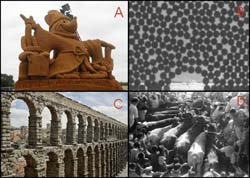Why do we shake the saltcellar before sprinkling the salt?

Figures A, B, C and D
Salt, as with rice, cement, sand, are finely divided solids which we call granular media. They are groups of similar particles that can behave as a liquid, flowing through orifices; or as a solid, given that they can maintain a constant shape and volume (see Fig A, sand sculptures). This is why the behaviour of granular media is curious and, on many occasions, problematic.
One of the intrinsic phenomena on handling granular media is the spontaneous formation of arches as shown in figure B. Arches are structures as used in architecture in order to construct bridges and aqueducts (figure C). These arches are referred to as being vaulted when formed in three dimensions and have the common feature that the particles forming them stabilize each other. That is, if one of the arcs making up the vaulted arch is eliminated, the whole structure will collapse.
When a granular medium flows through an orifice, the formation of the vaulting can cause a blockage. The flow of particles stops and the arch supports the weight of all the material on top of it, in the same way that the arches of a bridge support the weight of the vehicles crossing over it. The blockages in the flow of a granular medium cause serious problems in certain industrial processes. The plastics, cement and pharmaceutical industries are example of where granular media are the main players.
The blockages in discharging silos or dosifiers have physical properties in common with other kinds of hold-ups. Who has not been in a traffic jam, with the start of their holiday delayed? An example closer to home – and certainly more dangerous – is that of the bull running in the fiestas of San Fermín in Pamplona (figure D). When the street narrows and the runners run into each other, a spectacular accumulation of bodies occurs.
Over the past decade numerous scientists have been trying to understand the properties of obstructions of this nature, as well as the factors that are most influential in their formation. Nevertheless, there are many questions left unanswered. In this thesis Iker Zuriguel has investigated the simplest example of blockages that can be studied in the laboratory: a small silo full of spherical particles and with a circular orifice at its base. The thesis was presented at the University of Navarra.
Despite the apparent simplicity of the phenomenon, the unresolved questions are many. For example, what controls the phenomenon of blockages? The particle size? The size of the orifice? This thesis shows that the really important factor is the relationship between the radius of the orifice and that of the particle. Another important question: with the same size of particle and orifice, is it always the same number of grains that fall in an avalanche before the system blocks up? This research is a resounding proof that this is not so. For the same experimental conditions, we can find avalanches of 10 to 10,000 spheres!
The most important result of this thesis was the discovery that, in a 3-dimensional silo, when spherical particles are used, it suffices for the radius of the orifice to be five times greater than that of the particles in order that obstruction does not occur. And, as the saltcellar has holes less than this size, it is necessary to shake it in order to break up the arches formed and that impede the salt to free-flow on to our food.
Media Contact
All latest news from the category: Physics and Astronomy
This area deals with the fundamental laws and building blocks of nature and how they interact, the properties and the behavior of matter, and research into space and time and their structures.
innovations-report provides in-depth reports and articles on subjects such as astrophysics, laser technologies, nuclear, quantum, particle and solid-state physics, nanotechnologies, planetary research and findings (Mars, Venus) and developments related to the Hubble Telescope.
Newest articles

Properties of new materials for microchips
… can now be measured well. Reseachers of Delft University of Technology demonstrated measuring performance properties of ultrathin silicon membranes. Making ever smaller and more powerful chips requires new ultrathin…

Floating solar’s potential
… to support sustainable development by addressing climate, water, and energy goals holistically. A new study published this week in Nature Energy raises the potential for floating solar photovoltaics (FPV)…

Skyrmions move at record speeds
… a step towards the computing of the future. An international research team led by scientists from the CNRS1 has discovered that the magnetic nanobubbles2 known as skyrmions can be…





















